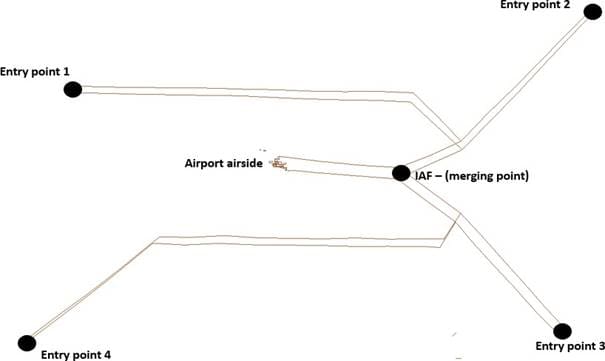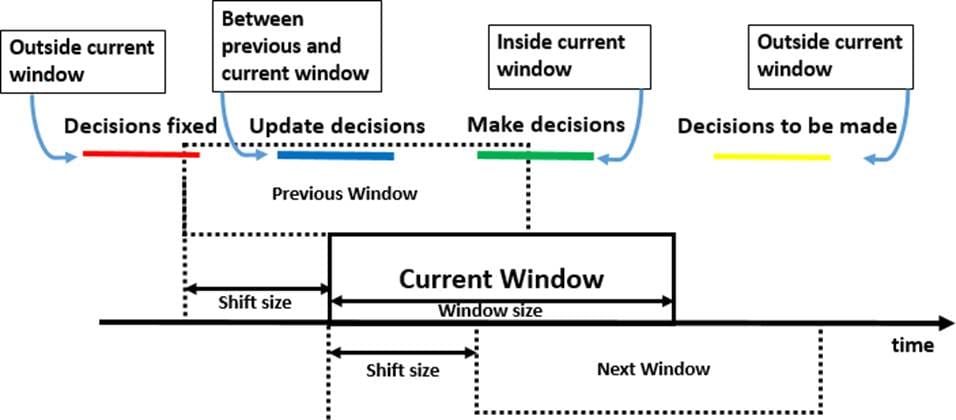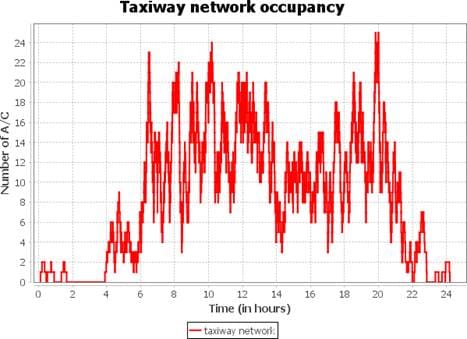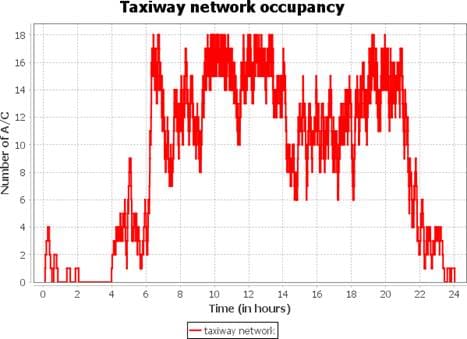by Paolo Scala and Miguel Mujica (Amsterdam University of Applied Sciences) and Daniel Delahaye (Ecole Nationale de l’Aviation Civile)
As presented at the 2017 Winter Simulation Conference
This paper deals with the improvement of the robustness of heuristic solutions for aviation systems affected by uncertainty when the resolution of conflicts is implemented. A framework that includes the use of optimization and simulation is described which in turn generates pseudo-optimal schedules. The initial solution is progressively improved by iteratively evaluating the uncertainty in the generated solutions and calibrating in accordance with the objective function. Simulation is used for testing the feasibility of a solution generated by an optimization algorithm in an environment characterized by uncertainty. The results show that the methodology is able to improve solutions for the scenarios with uncertainty, thus making them excellent candidates for being implemented in real environments.
Introduction
Airport Systems are considered as critical infrastructures that promote connectivity, value to the region and key for fostering the global interaction of different countries, industries and people. For that reason the expected growth is a threat for the current facilities and it should not be desirable to limit the growth by the technical limitations of the facilities. Furthermore, the airport is a connection of elements and processes that require proper tools for efficiently manage them. Airport operations can be distinguished in landside operations and airside operations, where landside operations are the ones that occur inside the terminals, and airside operations are the ones that occur outside the terminal. Regarding landside operations, it is possible to identify the passengers as entities and check-in desks, gates, or even recreational places like shops and cafe as resources. Regarding airside operations, aircraft can be identified as entities, and ground handling, runways, taxiways, airspace sectors, just to cite some of them, as resources. So from this classification it can be noticed that, in the airport system, two subsystems are identified, very different from each other and governed by completely different dynamics and logic. Moreover, these two different subsystems interact with each other and affect each other performance. So, the characteristics of an airport system, as previously described, are in line with the definition of complex systems given at the beginning of this section and therefore, airport systems should be considered as complex systems when they are analyzed. Another element that characterize aviation systems is the stochasticity, aviation systems are by nature stochastic and for that reason simulation is a key technique for getting the proper required insight in order to increase predictability. Furthermore, aviation is highly dependent on schedules, this also makes their problems prone to be improved by the use of optimization techniques. However, practitioners have recognized that optimization techniques alone fall short when they are used for solving capacity problems (Scala, Mujica, and Delahaye 2016). In this context a fundamental concept that needs to be considered is the robustness of solution coming from optimization models. Due to the variability of the system, a solution provided by an optimization model can cover several scenarios with uncertainty, so a solution is defined robust if it can be applied to more uncertain scenarios without major changes in performance.
In the literature there are many works that are related to the robustness of solution for aviation problems, the outcome of these works is the development of many tools and methodologies. Chandran and Balakrishnan (2007) proposed a dynamic programming algorithm for robust runway scheduling. In their work they considered uncertainties in the aircraft arrival times, coming up with a trade-off between runway throughput and probability of violating separation minimum on the runway as objective. Kim and Feron (2011) tackled the robust gate assignment problem when stochastic delays are introduced. They defined robustness as the interval time between two aircraft that park at the same gate, so the bigger is the interval the more robust is the solution. They computed the number and level of disturbed assignments and they solved the problem using a linear mixed 0-1 optimization model and the tabu search meta heuristic showing improvement, when compared to the original schedule, in the number and level of disturbed assignments of the 92% and 95%, respectively. In the work of Arias, Guimarans, Mujica, and Boosten (2013) the stochastic aircraft recovery problem is solved by employing constraint programming paradigm in combination with simulation techniques, the robustness of the solutions is assessed comparing the standard deviation obtained from simulated results with the variation of the probabilistic distribution used for generating stochastic delays, and its expected propagation due to the problem size. In the PhD thesis of Lee (2014) airport surface congestion problem was tackled, in his work he employed optimization for scheduling runways and taxiways operations and then stochastic simulation to deal with uncertainties. Narciso and Piera (2015) considered the robust gate assignment problem proposing a causal model employing coloured Petri nets (CPN) formalism obtaining the minimum number of gates necessary to absorb the traffic.
The focus of this paper is the improvement of robustness, as it was defined previously, for solutions coming from optimization models solved by meta heuristics. The methodology is iterative, and it aims at finding solutions which fit best in a system affected by uncertainties. In this paper it is presented an application of this methodology to the airport conflict detection and resolution problem. Results confirm that after two iterations, by changing parameters of the algorithm implemented for solving this problem, it is possible to get an improvement in the initial solution. The paper is organized as follows, in section 2 the problem tackled in this paper is described, then in section 3 the methodology is presented together with the description of the optimization and the simulation model. Section 4 shows the implementation of the methodology applied to the airport conflict detection and resolution problem and in the same section results are shown and discussed. In the final section, conclusions and future work is presented.
Problem Description
Nowadays, many European airports are on the edge of their capacity limitations and this can be attributed to the fast growing of the air traffic in the recent years. Moreover, a growth in the air traffic has been forecasted (Airbus 2016) for the upcoming years, therefore, in a future scenario of potential congestion, solutions need to be given to overcome this issue. Airport congestion is identified especially inside the airspace terminal manoeuvring area (TMA) and on the ground in the proximity of the runway entry. The TMA is a portion of the airspace that surrounds airports, here the flow of landing aircraft converge to the airport airside. A good management of arrivals and departures rate made by the air traffic controllers can relieve the airport, airspace and ground side, from potential congestion situations and at the same time increase the runway throughput (Frankovich 2012). The airport conflict detection and resolution problem, which has been considered in this paper, refers to the sequencing of the aircraft landing flow and ground capacity management. In this specific problem, conflicts are detected in the airspace due to separation minima restrictions, and on the ground due to capacity overloads. In the next sections conflicts for airspace, runways and ground components are described in more detail. The objective of solving this problem is to ensure safety for the aircraft flow in the airspace reducing the airspace conflicts to zero and reduce capacity overloads on the ground. For further and more detailed information about this problem please refer to Ma, Delahaye, and Sbihi (2016).
Airspace and Runway Conflicts
Concerning the airspace, given some landing routes merging at one final point (initial approach fix-IAF) (see Figure 1), and a set of landing aircraft, the main objective is to make the sequence of the aircraft so they will merge at the IAF without incurring in separation minima infringements. Regarding the runways, conflicts are detected when the separation between two consecutive aircraft that are crossing the runway is less than the required separation minima. Separation minima values are set according to the different runway operations, which can be arrivals (runway in) or departures (runway out), and they are based on the wake turbulence category of the leading and the trailing aircraft. Separation minima for the airspace are provided by ICAO standards (ICAO 2007) and separation minima for the runway are taken from Frankovich (2012).

Ground Conflicts
Concerning ground operations, the developed model is a high-level one, meaning that ground operations are not modeled in detail. So first the main components of the ground are identified and then a capacity is attributed to each of them. The main ground components identified are taxiways and terminals. Capacity is defined as number of aircraft that are simultaneously using one of the components. Once the aircraft have landed and exited the runway, they cross the taxiway until they park at the gate. As mentioned before the model of the ground is a high-level one, which means that taxiway routes were not considered in detail, therefore, taxiway operations were modeled using average travel time. Turnaround times were based on a real schedule, and the travel time on the taxiway from the gate until the departing runway entry was considered using average travel time. The objective is to do not exceed the capacity of these components, conflicts in this case are represented by the sum of maximum capacity overload and the average capacity overload. Table 1 shows the capacity of the main ground components related to the example considered in this work.
Table 1: Capacity for the main ground component.
| Ground component | Capacity |
| Taxiway network | 18 |
| Terminal 1 | 11 |
| Terminal 2 | 91 |
| Terminal 3 | 57 |









